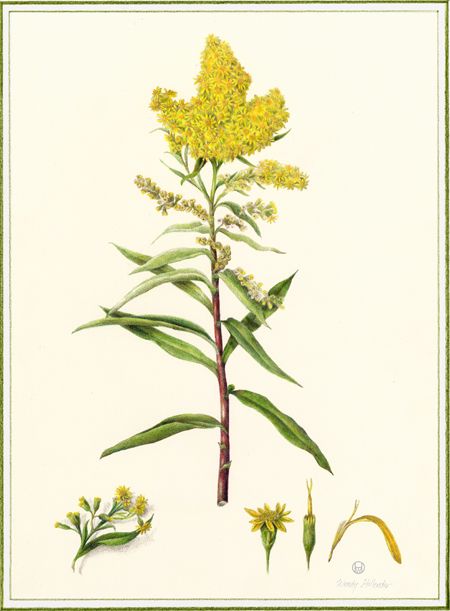Goldenrod, also known as Solidago, is a genus of wildflower that consists of 150 different species. The most common, Solidago canadensis, has alternating, lance-shaped leaves that are toothed around the edge and hairy underneath. It blooms pyramid-shaped clusters of yellow flowers July-October and grows up to 5 feet tall. It’s a great pollinator for butterflies and bees.
It can be found across North America, China, and Europe along roadsides and woodland edges.

Solidago contains numerous compounds that are beneficial to our heath including:
- saponins that have anti-inflammiroty and anti-fungal effects
- antioxidants quercetin and kaempferol that protect the body from free radical damage
People use goldenrod to relieve inflammation. Goldenrod is also a diuretic, which means it can help encourage a healthy urinary tract. It’s currently being tested for its ability to help with heart health, cancer prevention, weight control, and anti-aging.
Goldenrod has been prized for its healing properties since ancient times in China and Europe. Its vivid flowers are used as a yellow dye. The stem, leaves, and flowers are all edible. Fresh Goldenrod flowers are used on salads and as garnish. Leaves are used to make tea or cooked with other bitter greens like collards and added to soups and stews. Today some Goldenrod cultivars are popular garden perennials.
There are many tinctures and extracts that can be made out of goldenrod, but the most common form of consumption is goldenrod tea. Goldenrod tea can be made with fresh or dried goldenrod flowers and leaves. Steep 1 tablespoon of dried flowers and leaves (or twice as my fresh) in one cup of boiled water for at least 10 minutes. The flavor is slightly bitter.
Although many people blame Goldenrod for their seasonal hay fever, their pollen isn’t easily windblown and they are not likely to cause allergy problems for people. Goldenrod has no known toxicity, although the leaves contain latex, which is a common allergen. If you have a latex allergy, do not consume or use goldenrod. Because it’s a diuretic, you should not ingest goldenrod if you are taking other diuretic supplements.
References
https://www.britannica.com/plant/goldenrod
https://plants.usda.gov/core/profile?symbol=SOLID
https://www.oardc.ohio-state.edu/weedguide/single_weed.php?id=47
https://plants.ces.ncsu.edu/plants/solidago/
https://www.fs.fed.us/wildflowers/plant-of-the-week/solidago_altissima.shtml
https://www.ediblewildfood.com/goldenrod.aspx
http://www.efloras.org/florataxon.aspx?flora_id=1&taxon_id=242414377
https://pubmed.ncbi.nlm.nih.gov/16834988/
Jiang T, Huang BK, Qin LP. A survey of chemical and pharmacological studies on Solidago. Zhong Xi Yi Jie He Xue Bao. 2006 Jul;4(4):430-5. doi: 10.3736/jcim20060425. PMID: 16834988.
Starks CM, Williams RB, Goering MG, O’Neil-Johnson M, Norman VL, Hu JF, Garo E, Hough GW, Rice SM, Eldridge GR. Antibacterial clerodane diterpenes from Goldenrod (Solidago virgaurea). Phytochemistry. 2010 Jan;71(1):104-9. doi: 10.1016/j.phytochem.2009.09.032. Epub 2009 Oct 24. PMID: 19857881.
Podolak I, Galanty A, Sobolewska D. Saponins as cytotoxic agents: a review. Phytochemistry. 2010 Sep;9(3): 425-474. dio:10.1007/s11101-010-9183-z. PMID:20835386
Schätzle M, Agathos M, Breit R. Allergic contact dermatitis from goldenrod (Herba solidaginis) after systemic administration. Contact Dermatitis. 1998 Nov;39(5):271-2. doi: 10.1111/j.1600-0536.1998.tb05935.x. PMID: 9840279.
Chodera A, Dabrowska K, Sloderbach A, Skrzypczak L, Budzianowski J. Wpływ frakcji flawonoidowych gatunków rodzaju Solidago L. na diureze i stezenie elektrolitów [Effect of flavonoid fractions of Solidago virgaurea L on diuresis and levels of electrolytes]. Acta Pol Pharm. 1991;48(5-6):35-7. Polish. PMID: 1669338.
Latest posts by Emily Anderson (see all)
- What is Goldenrod used for? - October 13, 2020
Leave a Reply